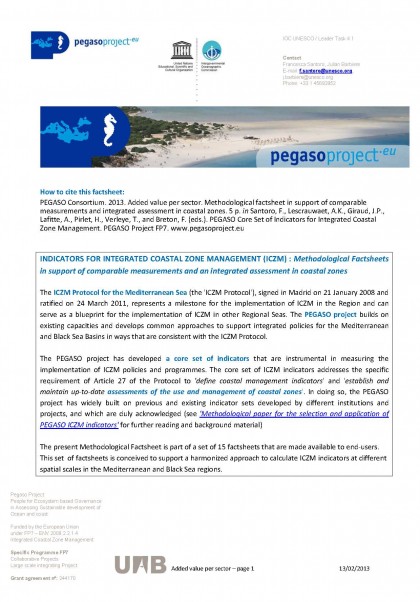
March 2014
 | March 2014 |
Indicators to measure sustainable development of coast and sea | |
|---|---|
 Application of the ICZM principles requires the development of a set of indicators and a good understanding of the direct and indirect drivers of change. The PEGASO indicators were selected on the basis of a review of the previous ICZM indicator framework, the needs of the ICZM Protocol and its link to the ecosystem approach, the requirements of other relevant European policy frameworks (the Marine Strategy Framework Directive, the Water Framework Directive and Natura 2000), and needs identified by the 10 pilot CASEs and the Integrated Regional Assessment. The work done in the context of PEGASO has helped review the current approaches to ICZM indicators and has filled in a number of gaps in terms of methodology and data collection and sharing. Fifteen methodological factsheets have been compiled and are now available not only for PEGASO partners but for the wider community interested in ICZM. PEGASO indicators have been used at different scales and in different contexts and have proven to be a useful tool for analysis and dissemination of results. The collaboration between the SDI developers and the CASE workers has revealed the potential for and benefits of harmonized and standardized data sharing. The dissemination activities have also shown the potential for the work done in PEGASO to be applied in other geographical contexts. The 27 indicators selected are intended to show the current state of coastal zones in terms of the environment, social and economic activities, threats and the status of ICZM implementation. Each indicator is also linked to the corresponding ICZM Protocol article and the ecological objectives of the UNEP Mediterranean Action Plan. These have been defined as part of the road map for application of the ecosystem approach in the Mediterranean as well as the future implementation of the EU Marine Strategy Framework Directive. One of the main lessons learnt has been that the achievements of coastal management plans and programmes should not be measured by sectoral indicators taken in isolation, if the aim is to promote a truly integrated approach. Prospects
| |